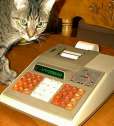Texas Instruments TI-60
| Datasheet legend
Ab/c:
Fractions calculation
AC: Alternating current BaseN: Number base calculations Card: Magnetic card storage Cmem: Continuous memory Cond: Conditional execution Const: Scientific constants Cplx: Complex number arithmetic DC: Direct current Eqlib: Equation library Exp: Exponential/log functions Fin: Financial functions Grph: Graphing capability Hyp: Hyperbolic functions Ind: Indirect addressing Intg: Numerical integration Jump: Unconditional jump (GOTO) Lbl: Program labels LCD: Liquid Crystal Display LED: Light-Emitting Diode Li-ion: Li-ion rechargeable battery Lreg: Linear regression (2-var. stats) mA: Milliamperes of current Mtrx: Matrix support NiCd: Nickel-Cadmium recharg. batt. NiMH: Nickel-metal-hydrite rech. batt. Prnt: Printer RTC: Real-time clock Sdev: Standard deviation (1-var. stats) Solv: Equation solver Subr: Subroutine call capability Symb: Symbolic computing Tape: Magnetic tape storage Trig: Trigonometric functions Units: Unit conversions VAC: Volts AC VDC: Volts DC |
| ||||||||||||||||||||||||||||||||||||||||||||||||||||||||
Texas Instruments TI-60
 Oh, no, not again! Another "almost programmable"! These calculators drive me nuts. They're nice, useful, accurate, and ergonomic... what on Earth possessed the designers at Texas Instruments to not include a GOTO and a conditional instruction? About the only reason I can think of is marketing: they probably didn't want to jeopardize the market of their higher-end programmable calculators.
Oh, no, not again! Another "almost programmable"! These calculators drive me nuts. They're nice, useful, accurate, and ergonomic... what on Earth possessed the designers at Texas Instruments to not include a GOTO and a conditional instruction? About the only reason I can think of is marketing: they probably didn't want to jeopardize the market of their higher-end programmable calculators.
The TI-60 (not to be confused with the SR-60, also from Texas Instruments) looks and feels very much like the TI-55-II or TI-55-III. Indeed, any differences are superficial, except that the TI-60 has about twice the amount of memory of the LCD TI-55s. Unfortunately, the completely unmerged programming model makes this larger program memory less useful than it could be. I have not, for instance, found a way to shoehorn a reasonable approximation of the Gamma function into this calculator.
One good thing: this calculator's RST button, when used in a program, does not stop program execution; instead, execution continues at step 0, so rudimentary loops are possible, just like on the original (LED display) TI-55. As an example, here again is a simple factorial implementation. When the calculation is complete, the program stops with an error, and the result can be recalled from memory register 0:
PC00 OP61 STO PC01 OP01 1 PC02 OP76 1/x PC03 OP71 RCL PC04 OP01 1 PC05 OP65 × PC06 OP61 STO PC07 OP00 0 PC08 OP53 ( PC09 OP71 RCL PC10 OP01 1 PC11 OP75 - PC12 OP01 1 PC13 OP54 ) PC14 OP22 RST


